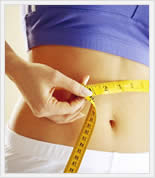 |
Already a member? Secure Login
|

- Ideal Weight Calculator
- Waist-to-Hip Ratio Calculator
- BMI Calculator
- Frame Size Calculator
- Target Heart Rate Calculator

- Good Fast Food
- Recipe Makeovers
- Meal Plans
- Nutrient Facts
- Food Label Claims
- Estimating Serving Sizes



Body Composition Testing
QUESTION:
I've heard a lot about getting my body composition measured. What is this and how do I get it done?
I've heard a lot about getting my body composition measured. What is this and how do I get it done?
ANSWER:
 Getting your body composition measured is an excellent way to help you monitor your progress in an exercise and nutrition program. When most people undertake such a program to get in shape, what they are really attempting to do is to "re-shape" their body. This "re-shaping" occurs when you lose body fat and gain muscle mass - either of which will change your body composition. Sometimes this is accompanied by an actual loss of body weight, but not always. To avoid frustration, ignore the scale and monitor body composition instead.
Getting your body composition measured is an excellent way to help you monitor your progress in an exercise and nutrition program. When most people undertake such a program to get in shape, what they are really attempting to do is to "re-shape" their body. This "re-shaping" occurs when you lose body fat and gain muscle mass - either of which will change your body composition. Sometimes this is accompanied by an actual loss of body weight, but not always. To avoid frustration, ignore the scale and monitor body composition instead.A body composition measurement will theoretically divide your body into two parts: fat mass and lean body mass. The lean body mass portion consists of your bones, connective tissue material, body water, organs and muscle mass. Your fat mass results will be presented to you as a "% body fat". A percent body fat above 25% for men, and above 32% for women, increases your risk for disease. However, healthy bodies do indeed contain and need fat! The minimal healthy levels of body fat are 5% for men and 12% for women.
Body composition assessment is commonly available at hospitals, fitness centers and university exercise science labs. Common methods include skinfolds, underwater weighing, the Bod Pod (air displacement), and bioelectrical impedance. Most methods require trained technicians to perform the test and you will be asked to follow some pre-test guidelines. Make sure you follow their directions carefully because this can greatly affect your results. Ideally, you should use the same method each time you get your body composition measured. Be aware that ALL methods have errors associated with them and some give more accurate results than others. Remember, these are indirect methods. The only direct means to assess your body fat with 100% accuracy would involve dissection! Make sure you understand the limitations of the test that you choose. For instance, some methods are better for obese individuals. A good technician will be able to guide you in choosing the best test method for you and will help you properly interpret your test results.
Although I highly recommend obtaining baseline body composition measurements and monitoring them, they should still only be used as a tool. Don't become a slave to them! Don't test too often because the tests are not sensitive enough to accurately measure small changes. Every two to three months is an ideal time period. Remember, how much you weigh is not as important as what composes a given body weight, and this is not as important as some of the other benefits that you will reap from your healthy lifestyle. Tracking body weight and/or body composition is only an indirect means to identify progress in your program and should not be the ultimate goal of your program.

Our expert, Dr. Sharon E. Griffin, holds a B.S., M.S., and Ph.D. in the areas of exercise science/physiology. She also holds a second M.S. degree in Nutrition and is a licensed nutritionist and an ACSM certified health and fitness instructor.
© 2024 MyFoodDiary.com. All Rights Reserved.